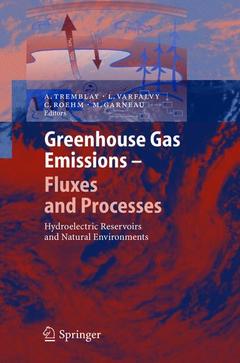Description
Greenhouse Gas Emissions - Fluxes and Processes, Softcover reprint of hardcover 1st ed. 2005
Hydroelectric Reservoirs and Natural Environments
Environmental Science Series
Coordinators: Tremblay A., Varfalvy Louis, Roehm Charlotte, Garneau Michelle
Language: English
Subjects for Greenhouse Gas Emissions - Fluxes and Processes:
Greenhouse Gas Emissions - Fluxes and Processes
Publication date: 10-2010
732 p. · 15.5x23.5 cm · Paperback
Publication date: 10-2010
732 p. · 15.5x23.5 cm · Paperback
Greenhouse gas emissions : Fluxes & proc esses, hydroelectric reservoirs & natural environments, (Environmental science) POD
Publication date: 11-2004
Support: Print on demand
Publication date: 11-2004
Support: Print on demand
Description
/li>Contents
/li>Comment
/li>
In a time when an unquestionable link between anthropogenic emissions of greenhouse gases and climatic changes has finally been acknowledged and * widely documented through IPCC reports, the need for precise estimates of greenhouse gas (GHG) production rates and emissions from natural as well as managed ecosystems has risen to a critical level. Future agreements between nations concerning the reduction of their GHG emissions will - pend upon precise estimates of the present level of these emissions in both natural and managed terrestrial and aquatic environments. From this viewpoint, the present volume should prove to a benchmark contribution because it provides very carefully assessed values for GHG emissions or exchanges between critical climatic zones in aquatic en- ronments and the atmosphere. It also provides unique information on the biases of different measurement methods that may account for some of the contradictory results that have been published recently in the literature on this subject. Not only has a large array of current measurement methods been tested concurrently here, but a few new approaches have also been developed, notably laser measurements of atmospheric CO concentration 2 gradients. Another highly useful feature of this book is the addition of - nitoring and process studies as well as modeling.
Résumé-Synthèse.- Analytical Techniques for Measuring Fluxes of CO2 and CH4 from Hydroelectric Reservoirs and Natural Water Bodies.- Development and Use of an Experimental near Infrared Open Path Diode Laser Prototype for Continuous Measurement of CO2 and CH4 Fluxes from Boreal Hydro Reservoirs and Lakes.- Greenhouse Gas Fluxes (CO2, CH4 and N2O) in Forests and Wetlands of Boreal, Temperate and Tropical Regions.- Diffuse Flux of Greenhouse Gases — Methane and Carbon Dioxide — at the Sediment-Water Interface of Some Lakes and Reservoirs of the World.- Organic Carbon Densities of Soils and Vegetation of Tropical, Temperate and Boreal Forests.- Carbon Dioxide and Methane Emissions from Estuaries.- GHG Emissions from Boreal Reservoirs and Natural Aquatic Ecosystems.- CO2 Emissions from Semi-Arid Reservoirs and Natural Aquatic Ecosystems.- A Comparison of Carbon Dioxide Net Production in Three Flooded Uplands (FLUDEX, 1999–2002) and a Flooded Wetland (ELARP, 1991–2002) Using a Dynamic Model.- Gross Greenhouse Gas Emissions from Brazilian Hydro Reservoirs.- Long Term Greenhouse Gas Emissions from the Hydroelectric Reservoir of Petit Saut (French Guiana) and Potential Impacts.- Production of GHG from the Decomposition of in vitro Inundated Phytomass and Soil.- Diffusive CO2 Flux at the Air-Water Interface of the Robert-Bourassa Hydroelectric Reservoir in Northern Québec : Isotopic Approach (13C).- The Use of Carbon Mass Budgets and Stable Carbon Isotopes to Examine Processes Affecting CO2 and CH4 Production in the Experimental FLUDEX Reservoirs.- Mass Balance of Organic Carbon in the Soils of Forested Watersheds from Northeastern North America.- Planktonic Community Dynamics over Time in a Large Reservoir and their Influence on Carbon Budgets.- Production andConsumption of Methane in Soil, Peat, and Sediments from a Hydro-Electric Reservoir (Robert-Bourassa) and Lakes in the Canadian Taiga.- Bacterial Activity in the Water Column and its Impact on the CO2 Efflux.- Production-Consumption of CO2 in Reservoirs and Lakes in Relation to Plankton Metabolism.- Impacts of Ultraviolet Radiation on Aquatic Ecosystems: Greenhouse Gas Emissions and Implications for Hydroelectric Reservoirs.- Impact of Methane Oxidation in Tropical Reservoirs on Greenhouse Gases Fluxes and Water Quality.- Using Gas Exchange Estimates to Determine Net Production of CO2 in Reservoirs and Lakes.- A One-Dimensional Model for Simulating the Vertical Transport of Dissolved CO2 and CH4 in Hydroelectric Reservoirs.- Modelling the GHG emission from hydroelectric reservoirs.- Synthesis.
Represents a keystone in the understanding of the GHG issue in the actual worldwide debate on the comparison of energy generation methods Includes supplementary material: sn.pub/extras
© 2024 LAVOISIER S.A.S.




